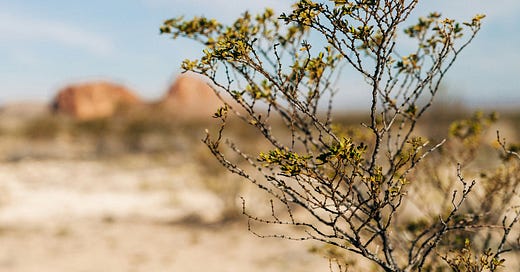Why does it smell so good in the desert after it rains? I remember asking my grandparents this the first time I experienced winter rains in Tucson. It didn’t smell like Chicago or Kansas City. It smelled earthy, raw, wet, warm, floral…I couldn’t quite describe it. Watching the clouds hunch their shoulders and release ribbons of rain felt so much more magical here than the vast plains and cities where I grew up. The whole earth smelled renewed.
Upon moving here as a teen, I learned that there was one particular reason the desert smelled this way. When we moved into my grandparent’s home, the surrounding land was, and is, filled with shaggy-maned, yellow flowered bushes. Golden bedhead. Uncombed cacophony. Whiskery tickles. I got to know them up close. Their most common English name in the Sonoran Desert is creosote; sometimes, they’re called greasewood or chaparral. In Tohono O’odham, segai. In Spanish, creosoto, or, in Sonora, they’re often called hediondilla. Hediondo means smelly.
The smell is what draws me to this plant- this bush, one to ten feet tall, that emits the scent of desert rain. Or, is it desert rain that emits the smell of creosote? How does this one plant hold the smell of an entire season? The brief explanation is chemical. There is a greasy (hence, greasewood) chemical on the leaves of creosote called petrichor (a friend once told me he can never remember the word petrichor so he just calls it pterodactyl). The etymology of the word petrichor suggests divinity: petr- meaning rock or stone, and ichor, meaning (no joke) “an ethereal fluid that flows through the veins of gods.” Petrichor refers to many plants, rocks and stones that emit a particularly divine smell after the rain.
Photo by Heather Mount on Unsplash
So when the skies open up in the desert, the droplets interact with the petrichor on creosote leaves, releasing that unbottled smell we desert dwellers know and love. For hours, it seems, the whole desert smells alive all because of the creosote plant. It is a plant of subtle power. It also has medicinal properties, and is great in a diaper rash salve for babies (we can attest) and in teas.
I thought I had learned as much as I could about creosote, and then recently, I stumbled upon something new; or rather, something old. Mesquite trees here in Tucson can be up to 200 years old. Some saguaro are similarly aged. I’ve often wondered if these plants could talk, what would they say about the changes in this valley over 200 years? They’d speak of the river, urbanization, the loss of the forests. Then, I read that the oldest creosote bush, who lives in the Mohave desert, is 11,700 years old. Excuse me. What?
Creosote reproduces by splitting its head into separate crowns when it reaches a certain age; it drops off a limb and births itself anew. Carbon testing showed that one particular patch of creosote, which has been named King Clone, is 11,7000 years old, one of the oldest living organisms on earth. Nearly 12,000 years ago in the southwest, giant sloths were just ending their era wandering the land. Prehistoric horses were still running wild. The climate was a warm and wet; streams flowed throughout the Mohave desert and there were lakes plopped across the surface. And there, in the middle of it all, was baby King Clone with her golden crown, making the desert smell of rain.
What would this 11,700 year old creosote tell us if she could speak in a way we could understand? What lessons exist in her staying power? Perhaps she’d say the more one stays still, the better one can survive. And yet, her seed spread throughout the whole region, creating vast landscapes of golden smells. Maybe she would whisper stories of the ancient horses or sloths eating avocados from ancient trees. She’d tell stories of humans, believed to be in the southwest 13,000 years ago, hunting down mammoths. She could tell me how different the land used to be- and how what I might perceive as truth is only a speck of reality. To be witness to life for that long- it’s a different type of trusting, of knowing, of remembering.
These days, find comfort talking with creosote around me. I gently rub their leaves in my fingers, the moisture of my skin releasing a whiff of desert rain. I wonder how old they are, and if creosote hundreds of miles apart can communicate. Do they share nutrients with one another like some trees do as they prepare to die? There is so much I don’t know about the invisible, yet visible, worlds all around me. It feels humbling to look at creosote in a new, old, way. To see it as a whiff of the ethereal, a reminder of the temporal. If you are in the desert, I encourage you to go visit one of these friends. Close your eyes, rub a few leaves together, and imagine a monsoon burbling in the distance. The rains are coming.
Read More:





